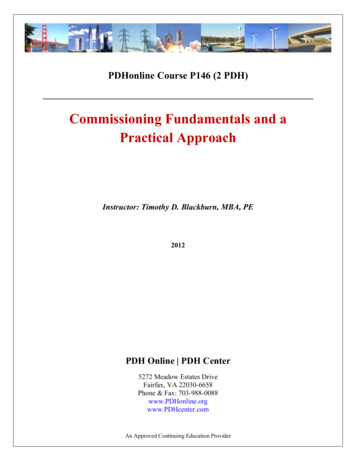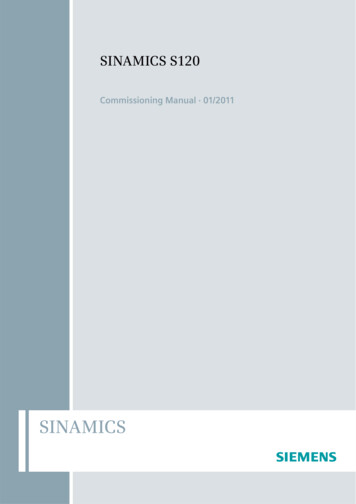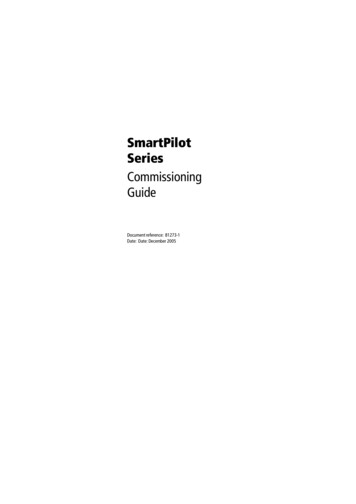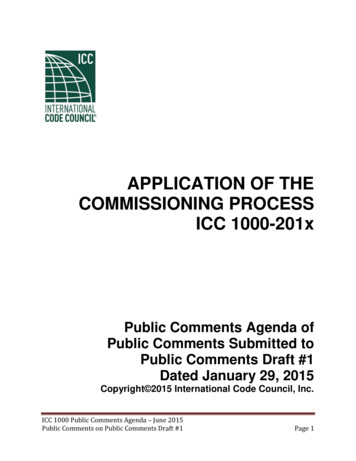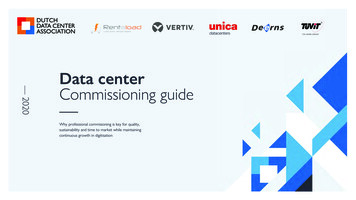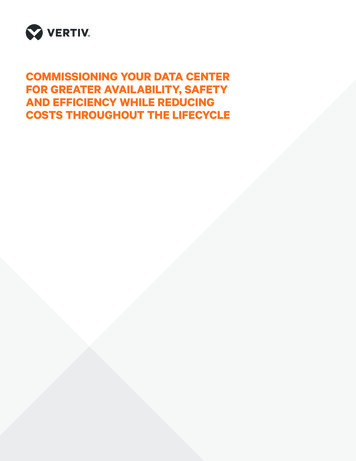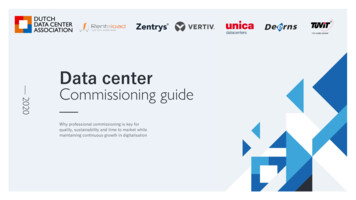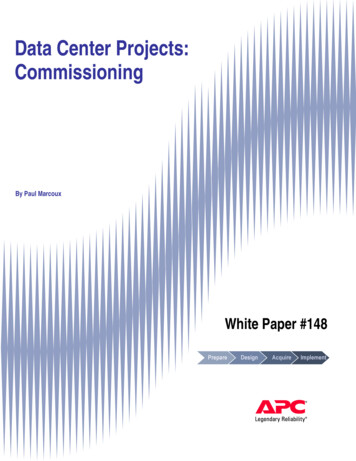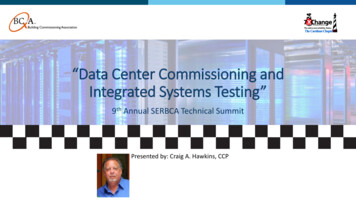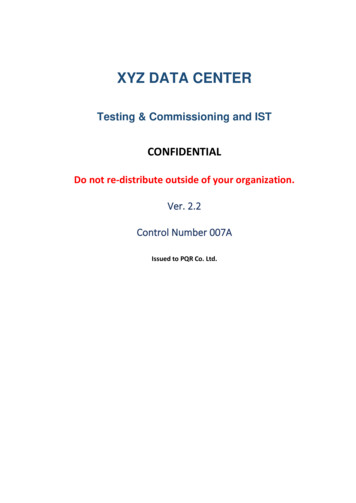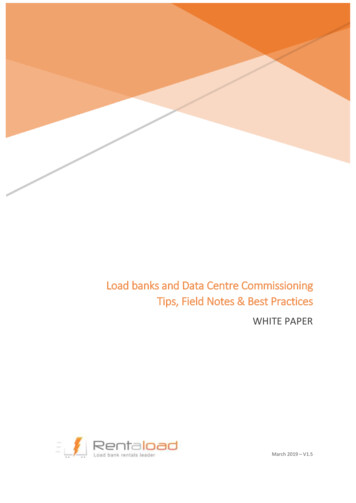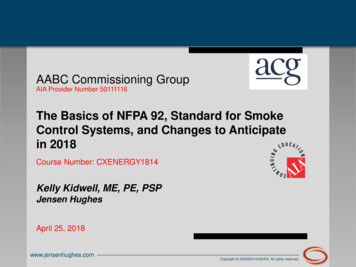
Transcription
AABC Commissioning GroupAIA Provider Number 50111116The Basics of NFPA 92, Standard for SmokeControl Systems, and Changes to Anticipatein 2018Course Number: CXENERGY1814Kelly Kidwell, ME, PE, PSPJensen HughesApril 25, 2018www.jensenhughes.comCopyright JENSEN HUGHES. All rights reserved.
Credit(s) earned on completionof this course will be reported toAIA CES for AIA members.Certificates of Completion forboth AIA members and non-AIAmembers are available uponrequest.This course is registered withwww.jensenhughes.comAIA CES for continuingprofessional education. As such,it does not include content thatmay be deemed or construed tobe an approval or endorsementby the AIA of any material ofconstruction or any method ormanner ofhandling, using, distributing, ordealing in any material orproduct.Questions related to specific materials,methods, and services will be addressed at theconclusion of this presentation.Copyright JENSEN HUGHES. All rights reserved.
Copyright MaterialsThis presentation is protected by US and International Copyright laws.Reproduction, distribution, display and use of the presentation without writtenpermission of the speaker is prohibited. JENSEN HUGHES 2018www.jensenhughes.comCopyright JENSEN HUGHES. All rights reserved.
COURSE DESCRIPTIONNFPA 92 applies to the design, installation, acceptance testing,operation, and ongoing periodic testing of smoke controlsystems. As the industry standard, it is important for designers,installers, and code enforcers to be familiar with the document,its history, and remain abreast of upcoming changes.www.jensenhughes.comCopyright JENSEN HUGHES. All rights reserved.
LEARNING OBJECTIVESAt the end of the this course, participants will be able to:1. Interpret the background and recent history of NFPA 92 and smoke controlsystems.2. Comprehend smoke control design objectives, design approaches, and designcriteria.3. Determine testing procedures and required documentation for smoke controlcommissioning.4. Understand how proposed changes to the 2018 edition can affect new designs andinstallations.www.jensenhughes.comCopyright JENSEN HUGHES. All rights reserved.
WHAT ARE SMOKE CONTROL SYSTEMS?“Engineered system that includes all methods that canbe used singly or in combination to modify smokemovement.”NFPA 92 §3.3.23.5www.jensenhughes.comCopyright JENSEN HUGHES. All rights reserved.
SMOKE CONTROL SYSTEMSwww.jensenhughes.comCopyright JENSEN HUGHES. All rights reserved.
SMOKE CONTROL SYSTEMSContainmentManagementA smoke control method that usesmechanical equipment to producepressure differences across smokebarriers.A smoke control method thatutilizes natural or mechanicalsystems to maintain a tenableenvironment in the means ofegress from a large-volume spaceor to control and reduce themigration of smoke between the firearea and communicating spaces.This Photo by JohnKlotewww.jensenhughes.comThis Photo by JohnKloteCopyright JENSEN HUGHES. All rights reserved.
WHAT IS TENABILITY?Tenable Environment: an environment in which smokeand heat are limited or otherwise restricted to maintainthe impact on occupants to a level that is not lifethreatening.This Photo by NPSwww.jensenhughes.comCopyright JENSEN HUGHES. All rights reserved.
NFPA 92 Standard for SmokeControl Systems Codes vs. Standardswww.jensenhughes.comCopyright JENSEN HUGHES. All rights reserved.
RECENT HISTORY NFPA 92A, Smoke Control Using Barriers andPressure Differences NFPA 92B, Smoke Management Systems in Malls,Atria, and Large Areas Now combined into NFPA 92 as of 2012www.jensenhughes.comCopyright JENSEN HUGHES. All rights reserved.
WHERE TO SEE SMOKE CONTROLBuildings with the followingphysical attributes/features:Verticals: Atria Detention/correctional Malls Health care Arenas Educational (K-12 and highered.) Concert/club venues Indoor theme parks High rises Industrial Amusement Culturalwww.jensenhughes.comCopyright JENSEN HUGHES. All rights reserved.
HOW TO REALLY TELL IBC Chapter 4 May be triggered by othersections Section 909 outlinesrequirements of systemswww.jensenhughes.com NFPA 101 Chapters 12-43 Section 9.3 outlinesrequirements of systemsCopyright JENSEN HUGHES. All rights reserved.
NFPA 92 BREAKDOWN Chapter 1: Administration Chapter 2: Referenced Publications Chapter 3: Definitions Chapter 4: Design Fundamentalswww.jensenhughes.comCopyright JENSEN HUGHES. All rights reserved.
NFPA 92 BREAKDOWN Chapter 5: Smoke Control Calculation Procedures 1/3 of the standard Chapter 6: Building Equipment and Controls Chapter 7: Smoke Control System Documentation Chapter 8: Testingwww.jensenhughes.comCopyright JENSEN HUGHES. All rights reserved.
NFPA 92 BREAKDOWN Appendices: There are 14This Photo by Unknown Author is licensed under CCBYwww.jensenhughes.comCopyright JENSEN HUGHES. All rights reserved.
DESIGN esignFire17Copyright JENSEN HUGHES. All rights reserved.
DESIGN PROCESSIs smokecontrolneeded? YESNOCreatedesign ESCheckcompliance COMPLIESCoordinate NO CHANGEDocumentTest PASSwww.jensenhughes.comFinishCopyright JENSEN HUGHES. All rights reserved.
DESIGN PROCESS: CALCULATION TOOLS “Hand” calculations Fire modeling software FDSPyrosimCONTAMCFAST Evacuation modelingwww.jensenhughes.comCopyright JENSEN HUGHES. All rights reserved.
DESIGN PROCESS KEY TAKE AWAYS Custom parameters Experienced designer Documentationwww.jensenhughes.comCopyright JENSEN HUGHES. All rights reserved.
BUILD THE THINGwww.jensenhughes.comCopyright JENSEN HUGHES. All rights reserved.
TESTINGSystem must be tested in accordance with its owndesign criteria – DESIGN REPORT IS IMPORTANTwww.jensenhughes.comCopyright JENSEN HUGHES. All rights reserved.
TESTING Physical inspection Component tests Acceptance testing Testing under four modesDoor opening forcemeasurementsControls activationOperation of componentsIn accordance with its owndesign parameterswww.jensenhughes.comCopyright JENSEN HUGHES. All rights reserved.
TESTING – LARGE VOLUME SPACES Identify all areas to bemeasured Verify: Operation of componentsMeasure exhaustcapacities and airvelocitiesMeasure door openingforces Where applicable,measure pressuredifferentialswww.jensenhughes.comCopyright JENSEN HUGHES. All rights reserved.
TESTING – SMOKE CONTAINMENT SYSTEMS Pressure testing Force testing Various types ofpressurized systems: StairwellElevator shaftLobbyVestibuleZonesArea of refugewww.jensenhughes.comCopyright JENSEN HUGHES. All rights reserved.
TESTING – CLOSE OUT Test firefighter controlpanel Provide testingdocumentation Address design criteria Schedule periodic testingwww.jensenhughes.comCopyright JENSEN HUGHES. All rights reserved.
CHANGES TO 2018 - UUKL Weekly self-test functionality of the smoke controlpanel New addition allows for bypass of actual activationupon AHJ approval Testing plan required; no less than semi-annually Affects to commissioning process: Must be UUKL listedOR have AHJ approval and test planwww.jensenhughes.comCopyright JENSEN HUGHES. All rights reserved.
CHANGES TO 2018 - TENABILITY Added in Appendix M Tool to aid in the design Affects commissioning: sets parameters for measurementduring acceptance testing Should make it more uniform across different jurisdictionswww.jensenhughes.comCopyright JENSEN HUGHES. All rights reserved.
REMINDERwww.jensenhughes.comCopyright JENSEN HUGHES. All rights reserved.
This concludes The American Institute of ArchitectsContinuing Education Systems CourseKelly Kidwell, ME, PE, PSPkkidwell@jensenhughes.comFor More Information ight JENSEN HUGHES. All rights reserved.
NFPA 92 applies to the design, installation, acceptance testing, operation, and ongoing periodic testing of smoke control systems. As the industry standard, it is important for designers, installers, and code enforcers to be familiar with the document, its history, and remain abreast of upcoming changes. COURSE DESCRIPTION

